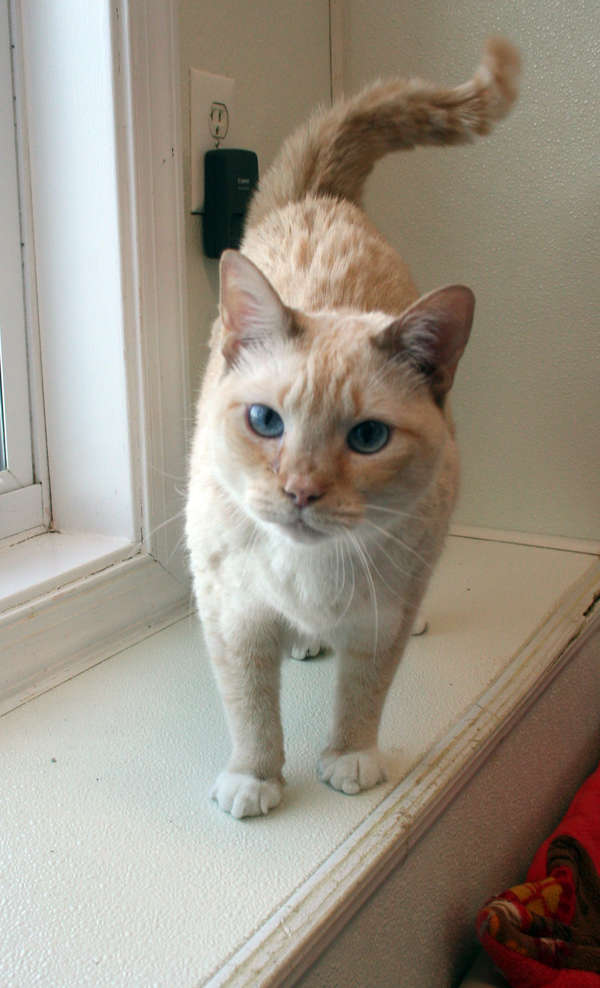I was remembering some of the great flames that came through our program, and it’s funny, because originally I was not at all sold on flames. But that quickly changed after I met Horatio. And Basil. And Firecracker. And and and…… the lovely lady Cheerios comes to mind.
Here was her write up:
Cheerios started her time with us back in 2014 when she came in to our program as a one year old. Now while we guess about cat’s ages in our program as we rarely are given any paperwork actually verifying a birth date, it’s pretty easy to tell with the very young and the very old as to how old they are. So while we might be off by a month or two with Cheerios, I doubt we are off much more than that.
Poor Cheerios was dumped in a filthy sticky carrier at the animal shelter in Baltimore. She had been declawed by her first owner, and she came from there into a foster home in Maryland, where she stayed for 50 days before being adopted by a young couple with no children and no other cats. About two years after having her, they had a baby, and a year later, when the baby was toddling, Cheerios and the baby were at odds. From what I could tell from the father, who brought us Cheerios back, the toddler didn’t have the best cat manners, and Cheerios didn’t appreciate the toddler, and there was some swatting and hissing that happened. The parents were afraid that things would get out of hand, and decided it best to return Cheerios.
From the time that she originally came to us, Cheerios had a bit of a congestion problem. During the time we had her initially, the time the first adopter had her and then currently, she has had multiple vet visits, a scope to look for polyps, a nasal flush etc., and she continues with some congestion. This tells us that most likely what happened is she got the herpes virus early on as a kitten, and as in humans (although it doesn’t cross species), the herpes virus is for life. It comes and goes during times of stress, and manifests itself in some congestion and runny eyes. So she’s basically a chronic snuffler and one with watery eyes. In a calm quiet and stable environment, this is likely to be minimal, but during times of stress, such as when she first gets home, when things change in the home, new people are added or subtracted, it will be worse. For cats who have long term congestion, what happens is the small nasal hairs that work to catch normal amounts of phlegm no longer work as they are worn away, so there is more discharge than a normal person, say, who just has a bit of a sniffly nose. When she first was returned to us, there were some major sneezes with some icky gobs of mucous coming out; after she was here about two weeks, however, while I hear a sneeze now and then, I am not noting much discharge from the nose at all. Her right eye, however, does run, and because she’s a flame point, it almost looks like it’s running brown liquid (it’s really just the coloring of the discharge against her fur). Nothing that a little wipe (probably daily) can’t clean up.
Her food habits are normal, though she’s maybe 1/4 pound too heavy. I wouldn’t feed her junk food. Flames typically do have sensitive stomachs but I’m not seeing it with her. She’s a bit of a litter kicker but otherwise just fine in the litter department. She was overgrooming a bit in the previous home, this means licking at herself to the point of nakedness – this can be seen between her back legs on her stomach area and at one place near her tail (although this latter one has just about grown back in). She may never grow hair on her stomach.
Her personality is amazing .While she’s typically female which means she’s not a pick up and lug around, hold like a baby type cat, she is SO friendly. She pats your cheek and your arm, she flops over and shows your belly, she rubs against legs, she loves pets and attention. She makes great eye contact, comes running when you walk in the room, and is just an amazing companion. She does NOT like other cats, so while she will be okay for a few hours, if they are too forward with her at all, she takes a very dominant stance and things need intervention quickly before they go down hill. If she’s very nervous in her environment or with new people she will hiss half heartedly,
She’s a good sized gal at almost 13 pounds, a flame with striping on her tail and white paws.
She went home to an older couple and lasted about a month before being returned for not using the litterbox. Why? I don’t know. They said she was the most loving cat they ever had. They said she laid on the couch touching them both, that she adored them and the husband in particular adored her. But something was amiss and she peed every so often out of the box. The husband brought her back and stood here with tears pouring down his cheeks because he liked her so much.
She uses the box just fine here. I don’t know what her issue is honestly, although declawed cats have a tendency to have litterbox problems. I know her adopter should provide two pristine boxes, should scoop daily, should use a very soft unscented litter, should not have other cats, should have a calm and patient household and should be willing to try.
She is the nicest cat almost ever. Truly.
Cheerios was adopted by Tonya in NC and ruled a roost consisting of 5 dogs!
VA12892 and VA12962

Can’t you just read that face ready to headbutt and kiss you? Who else is a flame fan?
